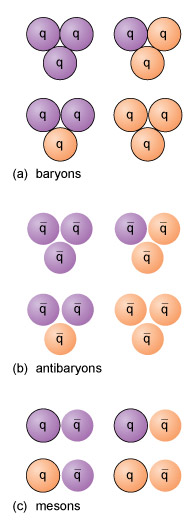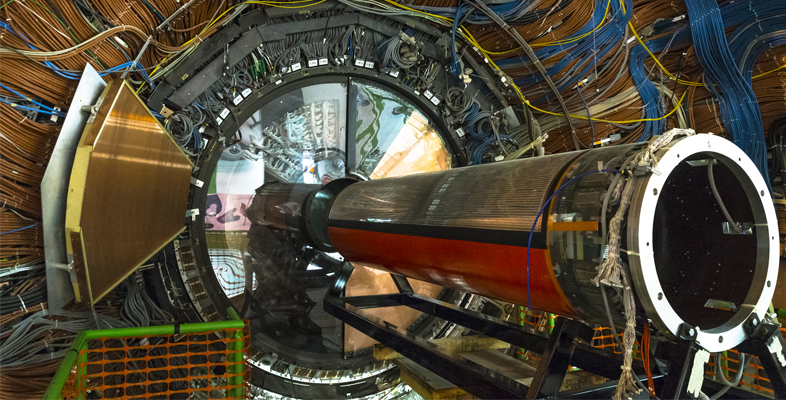4.1 Building a hadron
Quarks and antiquarks only occur bound together inside hadrons; they have never been observed in isolation. While it may seem like the process of ‘building’ a hadron would be something very complicated (and yes, the underlying physics is indeed complex), there are in fact 3 simple ‘recipes’ to remember.
A hadron can consist of either:
- Three quarks (in which case it is called a baryon).
- Three antiquarks (in which case it is called an antibaryon).
- One quark and one antiquark (in which case it is called a meson).

Activity 1 The quark fruit machine
In this activity, you will play on a ‘fruit machine’ to investigate the combinations of quarks and antiquarks that make up different baryons, antibaryons and mesons. Read the introduction and then click on the tabs to answer questions relating to each type of hadron within the fruit machine. Finish by reading the summary.
Any combination of quarks and antiquarks that obeys one of the three recipes above is a valid hadron. The net electric charge of a hadron is simply the sum of the electric charges of the quarks or antiquarks of which it is composed. As you saw in the activity, the net charge of a hadron is therefore always a whole number, despite the fact that the quarks themselves have non-whole number electric charge.
As a specific example of the hadron-building recipe, the proton is a baryon, so it is composed of three quarks, and as mentioned above, it is composed of up and down quarks only.
The proton has a charge of +e. The only way that three up or down quarks can be combined to make this net charge is by combining two up quarks with a down quark. So the quark content of a proton is (uud), giving a net charge of .
What is the antiquark composition and charge of an antiproton?
An antiproton has a similar composition to a proton but is composed of antiquarks rather than quarks. Its composition is therefore giving a net charge of .
What combination of three up or down quarks would make a neutron?
A neutron has zero charge and is composed of three up or down quarks, so its quark content must be (udd), giving a net charge of .
Pions are the least massive examples of mesons. They are composed of only up or down quarks and antiquarks. What do you suppose are the compositions of the following pions: π+, π−, π0? (The superscript indicates the electric charge in each case).
- π+ must be composed of giving a net charge of .
- π− must be composed of giving a net charge of .
- π0 could be composed of or giving a net charge of or . (In fact neutral pions exist with either composition.)
The tally of six leptons and six quarks, each with their own antiparticles, may seem like a huge number of fundamental particles, but don’t let this put you off. Virtually everything in the Universe is made up of merely the first generation of each type of particle (see Tables 1 and 2), namely:
- electrons
- up quarks, and
- down quarks,
with electron neutrinos being created in radioactive decays.
As for the other generations:
- the second generation of leptons (muon and muon neutrino)
- the second generation of quarks (charm and strange)
- the third generation of leptons (tauon and tauon neutrino), and
- the third generation of quarks (top and bottom)
all have exactly the same properties as their first-generation counterparts except that they are more massive.
Quite why nature decided to repeat this invention three times over is not currently understood!
